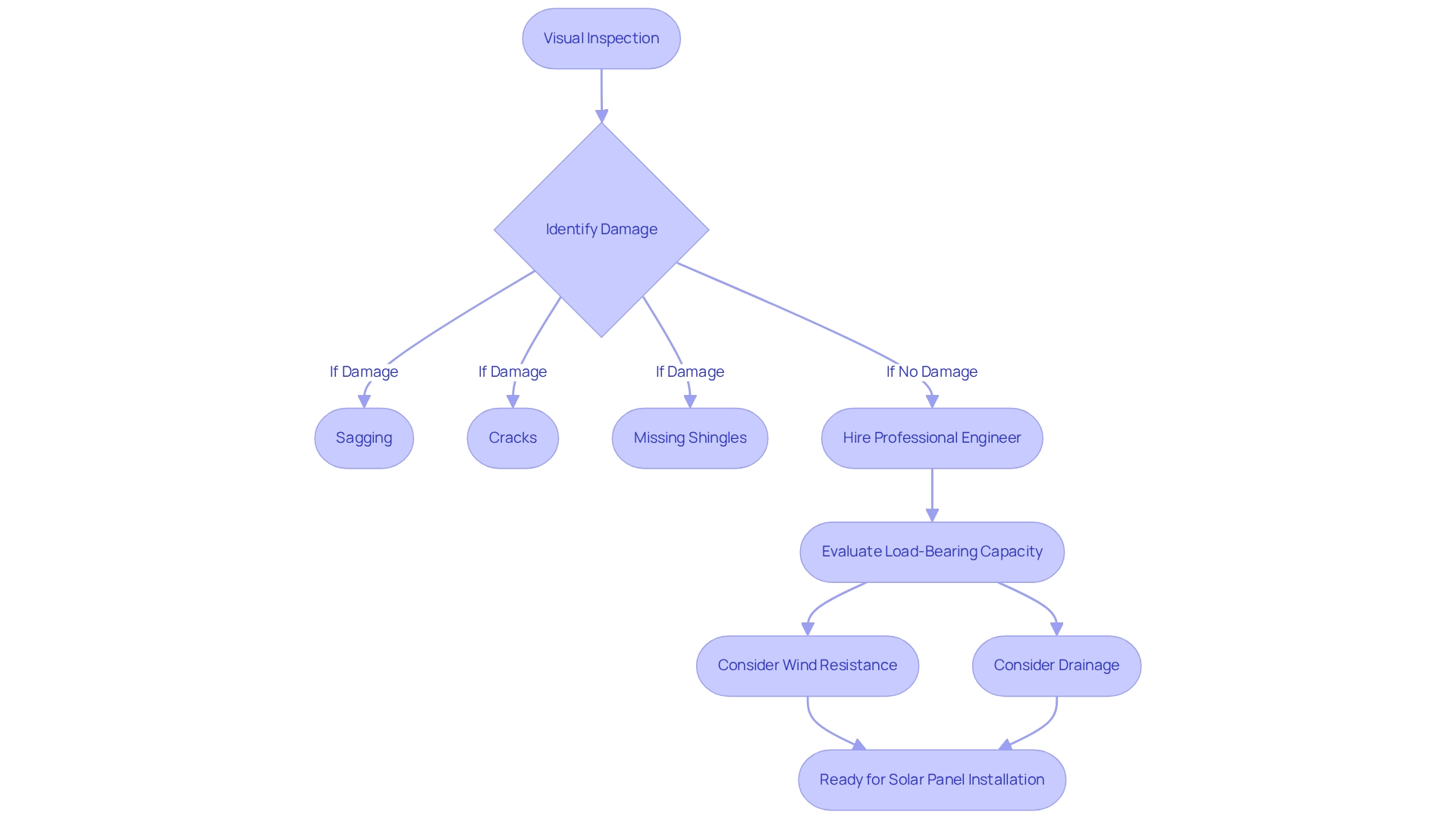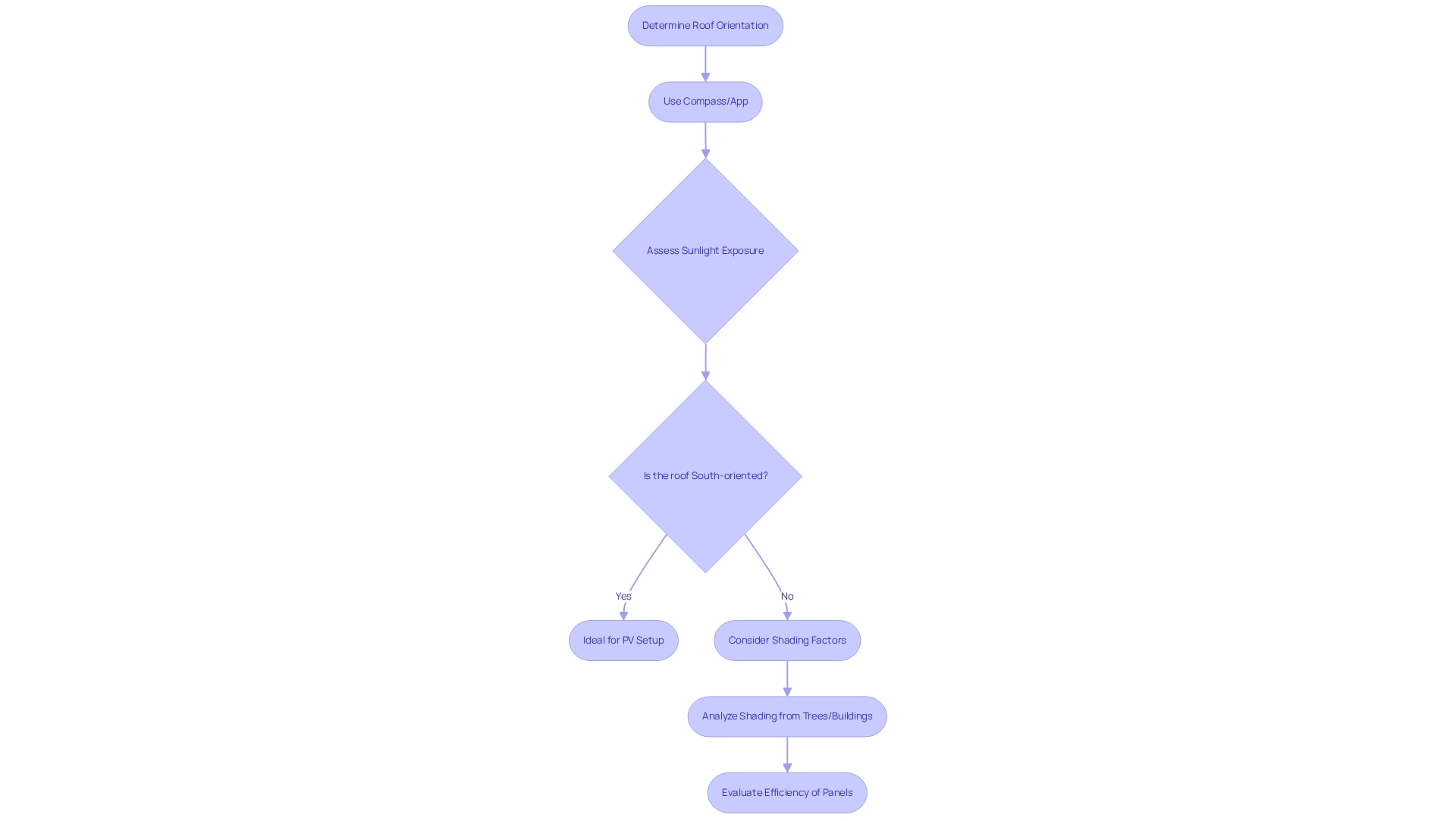Overview
Are you worried about rising energy bills? You’re not alone. Many homeowners share your concerns, and that’s why exploring solar energy can be a transformative step towards energy independence. Understanding whether your roof can support solar panels is crucial, and we’re here to guide you through this important decision.
First, it’s essential to evaluate the structural integrity of your roof. This means checking if it can handle the weight of solar panels and installation requirements. Additionally, consider the roof material and orientation, as these factors significantly influence solar energy efficiency. Consulting with installation experts can provide you with the reassurance you need, ensuring that your roof is a safe and suitable candidate for solar panels.
Together, we can make informed choices that not only help reduce your energy bills but also contribute to a sustainable future. By taking these steps, you’re not just investing in your home; you’re investing in a cleaner environment for generations to come. If you have any questions or need assistance, please don’t hesitate to reach out. We’re here to support you every step of the way.
Introduction
As homeowners, we often find ourselves grappling with rising energy bills and the pressing need to make environmentally conscious choices. In light of this, many are turning to solar panel installations as a promising solution to not only reduce energy costs but also contribute positively to our planet.
However, we understand that embarking on this eco-friendly journey can feel overwhelming. Before diving into the world of solar energy, it’s essential to consider several critical factors that will ensure a successful setup.
- Assessing the structural integrity of your roof
- Analyzing materials and orientation
Each step is crucial in determining the feasibility and efficiency of solar energy systems. Engaging with experienced professionals can further ease your concerns, offering tailored insights that cater to your unique roofing conditions and local regulations.
Together, we can explore the essential considerations for harnessing solar energy effectively, paving the way for a smooth transition to sustainable living.
Evaluate Your Roof’s Structural Integrity
Begin by visually examining your structure for any signs of damage, such as sagging, cracks, or missing shingles. A simple walk around your home can help identify these issues. We understand that ensuring your home is in good condition is vital for peace of mind. For a more thorough assessment, it is advisable to hire a professional structural engineer. They will evaluate the load-bearing capacity of your structure by examining the materials, age, and any previous repairs.
It’s essential to determine if my roof can support solar panels, as your structure must support at least 20 pounds per square foot, which is the standard weight requirement for solar panels. Recent studies indicate that to determine if my roof can support solar panels, it’s crucial to ensure structural integrity before installation. Furthermore, consider elements like wind resistance and drainage, particularly for level surfaces, to avoid future issues.
It’s common to feel overwhelmed when placing photovoltaic panels on a level surface; ensure to consider the structure’s integrity, shading, wind resistance, and how water will flow away. Engaging with experts who focus on , such as Powercore Electric, can provide valuable insights into your roof’s suitability, ensuring a dependable and efficient energy system.
With over 30 years of experience serving the California community, Powercore Electric emphasizes customer support and offers continuous assistance after setup, greatly enhancing the long-term satisfaction and efficiency of your energy system.
“We saved over 30% on our energy bills within the first year! Powercore’s team made the process easy and affordable,” says Jane D., a satisfied customer.
Ready to explore how Powercore Electric can help you? Together, let’s work towards a sustainable future—get your free, personalized estimate now!
Analyze Roof Material and Condition
Start by considering your roofing material, as it significantly impacts whether I can determine if my roof can support solar panels for installing photovoltaic systems. Common options include asphalt shingles, metal, tile, and flat structures, each offering unique benefits and challenges. For example, metal coverings are renowned for their resilience and exceptional weight capacity, leading to the inquiry of whether my roof can support solar panels. On the other hand, while asphalt shingles are widely used, they typically have a shorter lifespan of about 20 years, which may necessitate replacement before panel installation to prevent future issues. Additionally, timber coverings are generally not recommended for direct installation of photovoltaic systems due to their combustibility and limited load-bearing capacity.
Next, it’s essential to carefully evaluate the condition of your roof. If you notice signs of wear or if it’s nearing the end of its lifespan, considering a replacement is wise. This proactive approach not only ensures a solid foundation for photovoltaic systems but also addresses the question of how can my roof support solar panels while enhancing energy efficiency and longevity. Property owners should also be aware of government initiatives that can assist with the costs associated with roof replacement and renewable energy installation, making the transition to clean energy more achievable. To verify if can my roof support solar panels, follow these steps:
- Ensure your roof is structurally sound and free of damage.
- Choose the appropriate photovoltaic system based on your energy needs and type of structure.
- Obtain necessary permits and approvals from local authorities.
- Hire a qualified installer to mount the units and connect them to your electrical system.
Statistics reveal that asphalt shingles are the most common roofing material in California, followed by tile and metal options. The durability and compatibility of each material with photovoltaic systems vary, raising the question of whether my roof can support solar panels, as metal coverings often outlast asphalt in terms of longevity and support for energy installations. Current trends highlight a growing preference for lightweight and durable roofing materials that enhance energy system efficiency, which is crucial for homeowners looking to maximize their investments in renewable energy.
Aesthetic considerations are also important; homeowners should reflect on how energy systems will affect the overall appearance of their homes. Expert insights suggest that investing in high-quality roofing can significantly impact the effectiveness of energy systems, ensuring homeowners reap the maximum benefits from their energy investments. Furthermore, understanding how photovoltaic systems operate and selecting the ideal batteries for energy storage can enhance the overall efficiency of the energy system.
Case studies illustrate successful photovoltaic installations across various structures, including insights from Polaron Solar Company, which has helped over 12,000 households transition to renewable energy. Their commitment to delivering high-quality systems underscores the importance of choosing the right roofing materials. Additionally, Polaron emphasizes providing clients with and substantial savings through their industry-leading low-interest energy programs.
With the right preparation and material choice, homeowners can effectively harness renewable energy, regardless of their roofing conditions.
Determine Roof Orientation and Sunlight Access
We understand that as a homeowner, you might be concerned about your energy bills and the impact of your choices on the environment. Assessing the orientation of your structure is a crucial first step. South-oriented structures generally receive , making them ideal for photovoltaic setups. You can easily determine your orientation using a compass or a smartphone app.
It’s also important to consider any potential shading from trees, buildings, or other structures that could block sunlight. Ideally, your roof should experience minimal shading during peak sunlight hours, which typically fall between 10 AM and 4 PM. If shading cannot be avoided, don’t worry—there are energy panels with higher efficiency ratings that can help offset the decreased sunlight.
For renters in Long Beach, understanding these elements is essential for accessing eco-friendly energy options and maximizing the benefits of renewable energy. Together, we can explore how you can make informed decisions that lead to energy independence and a more sustainable future.
Consult with Solar Installation Experts
We understand that navigating the complexities of energy bills can be overwhelming. After assessing your roof’s structural integrity, material, and orientation, it’s crucial to consult local installation specialists like Powercore Electric to find out if my roof can support solar panels through a comprehensive professional evaluation. As a proud, locally-owned business, Powercore is deeply attuned to of California communities, ensuring customized recommendations based on your unique circumstances. During your consultation, consider asking about:
- Their experience in the industry
- The specific types of panels they recommend
- The warranties or maintenance services they offer
This step is essential to ensure that your energy system is safe, efficient, and compliant with local building regulations, and to determine if it can my roof support solar panels.
It’s common to feel uncertain about where to start, especially with only 25% of installers reporting increased demand in 2024. This statistic underscores the importance of seeking expert guidance in a competitive market, where informed decisions are vital for homeowners. Furthermore, recent developments in battery storage manufacturing highlight the growing importance of reliable energy solutions, making professional evaluations even more pertinent in 2025. Interacting with informed experts can greatly improve your likelihood of a successful energy system setup. For instance, a recent project in California achieved a remarkable 30% boost in energy efficiency by adhering to professional evaluations.
Moreover, with 39% of homeowners contemplating renewable energy systems in the U.S., the increasing interest in clean energy makes consulting with specialists like . Together, we can navigate the complexities of installation and ensure you make the best choice for your home. Testimonials from satisfied customers highlight Powercore’s commitment to quality craftsmanship and customer-first service, reinforcing the value of their expertise in ensuring a successful solar project. Let’s work towards a brighter, more sustainable future together.
Conclusion
Transitioning to solar energy is a powerful step towards not only reducing your energy costs but also nurturing a sustainable future for all of us. We understand that embarking on this journey can feel daunting, so it begins with a careful evaluation of your roof’s structural integrity, materials, and orientation. Ensuring that your roof can support solar panels and is in good condition is essential for a successful installation. By understanding the unique characteristics of your roofing material, you can make informed decisions that will enhance the longevity and efficiency of your solar system.
Moreover, assessing your roof’s orientation and potential shading is critical to maximizing sunlight exposure, directly impacting energy production. Consulting with experienced solar installation professionals, like Powercore Electric, can provide you with tailored insights that alleviate concerns and streamline the installation process. Their expertise not only ensures adherence to local regulations but also enhances the overall effectiveness of your solar energy system.
In summary, careful planning and professional guidance are paramount in harnessing the full potential of solar energy. By taking these critical factors into account, you can confidently embark on your solar journey, contributing to a greener planet while enjoying the financial benefits of renewable energy. The time to invest in solar is now; together we can pave the way for sustainable living and a brighter future for generations to come. Let’s work towards making your solar dreams a reality.





